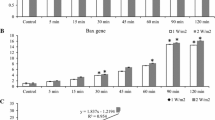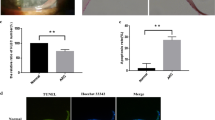Summary
To investigate the effect of proteasome inhibitor MG132 on the apoptosis of bovine lens epithelial cells (BLECs), the cells were treated with MG132 at different concentrations for12, 24 and 36 h. The cell viability was analyzed by MTT assay and the effect of MG132 on the apoptosis of BLECs was assessed by flow cytometry (FCM). The results showed that after treatment for the same period, the inhibitory effect of MG132 on BLECs proliferation was enhanced with the increment of the concentration of MG132 (0, 2, 5, 10, μmol/L) (P<0.05). The 50% inhibiting concentration (IC50) was 2.03 μmol/L when the BLECs were treated with MG132 for 36 h. MG132 also induced the apoptosis of BLECs obviously. FCM showed that the apoptosis index of the cells treated by MG132 at 2 μmol/L for 12 h was (20.24±1.51)%, and that of the control was (0.98±0.20)% respectively (P<0.01, n=3). It was concluded that MG132 could lead to apoptosis of BLECs. The decrease of proteasome activity may play an important role in the formation and development of cataract.
Similar content being viewed by others
References
Li W C, Kuszak J R, Dunn K et al. Lens epithelial cell apoptosis appears to be a common cellular basis for non-congenital cataract development in human and animals. J Cell Biol, 1995,130:169–181
Li W C, Kuszak J R, Wang G M. Calaimycin-induced lens epithelial cell apoptosis contributes to cataract formation. Exp Eye Res, 1995,16(1):91–98
Li W C, Spector A. Lens epithelial cell apoptosis is an early event in the development of UVB-induced cataract. Free Radic Biol Med, 1996,20(3):301–311
Doherty F J, Dawson S, Mayer R J. The ubiquitin proteasome pathway of intracellular proteolysis. Essays Biochem, 2002,38:51–63
Ciechanover A. Intracellular protein degradation: from a vague idea thru the lysosome and the ubiquitin-proteasome system and onto human diseases and drug targeting. Cell Death Differ, 2005,12:1178–1190
Hershko A. The ubiquitin system for protein degradation and some of its roles in the control of the cell division cycle. Cell Death Differ, 2005,12(9):1191–1197
Shang F, Taylor A. Function of the ubiquitin proteolytic pathway in the eye. Exp Eye Res, 2004,78:1–14
Hershko A, Ciechanover A, Varshavsky A. The ubiquitin system. Nature Med, 2000,6:1073–1081
Shang F, Dong G, McAvoy J W et al. Ubiquitin dependent pathway is upregulated in differentiating lens cell. Exp Eye Res, 1999,68(2):179–192
Pereira P, Shang F, Hobbsa M et al. Lens fibers have a fully functional ubiquitin-proteasome pathway. Exp Eye Res, 2003,76(5):623–631
Yan H, Harding J J, Hui Y N et al. The decreased chaperone activity of α-cry-stallin in selenite cataract may result from selenite-induced aggregation. Eye, 2003,17(5):637–645
Truscott R J. Age-related nuclear cataract-oxidation is the key. Exp Eye Res, 2005,80:709–725
Bloemendal H, de Jong W, Jaenicke R et al. Ageing and vision: structure, stability and function of lens crystallins. 0rog Biophys Mol Biol, 2004,86:400–407
Carrard G, Bulteau A L, Petropoulos I et al. Impairment of proteasome structure and function in aging. Int J Biochem Cell Biol, 2002,34(11):1461–1474
Orlowski R Z. The role of the ubiquitin-proteasome pathway in apoptosis. Cell Death Differ, 1999, 6:303–313
Drexler H C. Activation of the cell death program by inhibition of proteasome function. Proc Natl Acad Sci USA, 1997,94:855–860
Nakamura T, Pichel J G, Williams-Simons L et al. An apoptotic defect in lens differentiation caused by human p53 is rescued by a mutant allele. Proc Natl Acad Sci USA, 1995,92:6142–6146
Choudhary S, Zhanag W, Zhou F et al. Cellular lipid peroxidation end-products induce apoptosis in human lens epithelial cells. Free Radic Biol Med, 2002,32:360–369
Kato, K, Kurosaka, D, Nagamoto, T. Apoptotic cell death in rabbit lens after lens extraction. Invest Ophthalmol Vis Sci, 1997,38:2322–2330
Zhang T Y, Liu Y Z, Wu M X et al. The Comparison of proteasome activity in the senile cataract lens epithelium and transparent lens epithelium. Ophthalmol J, 2006,22:89–92
Author information
Authors and Affiliations
Additional information
Xing XING, female, born in 1984, Doctoral Candidate
Rights and permissions
About this article
Cite this article
Xing, X., Hu, Y., Cao, Y. et al. The apoptosis of bovine lens epithelial cells induced by proteasome inhibitor MG132. J. Huazhong Univ. Sci. Technol. [Med. Sci.] 28, 469–471 (2008). https://doi.org/10.1007/s11596-008-0421-1
Received:
Published:
Issue Date:
DOI: https://doi.org/10.1007/s11596-008-0421-1




